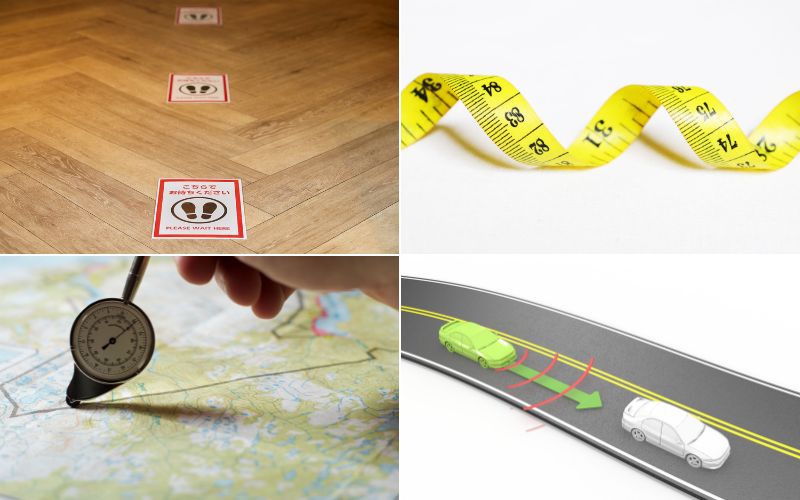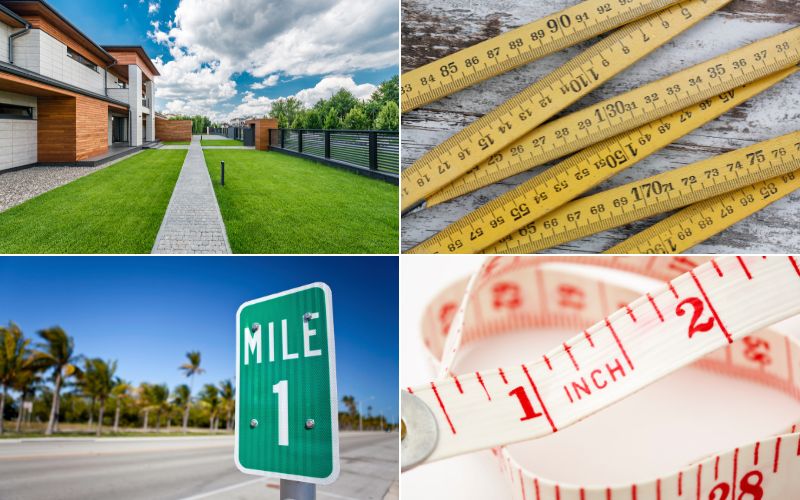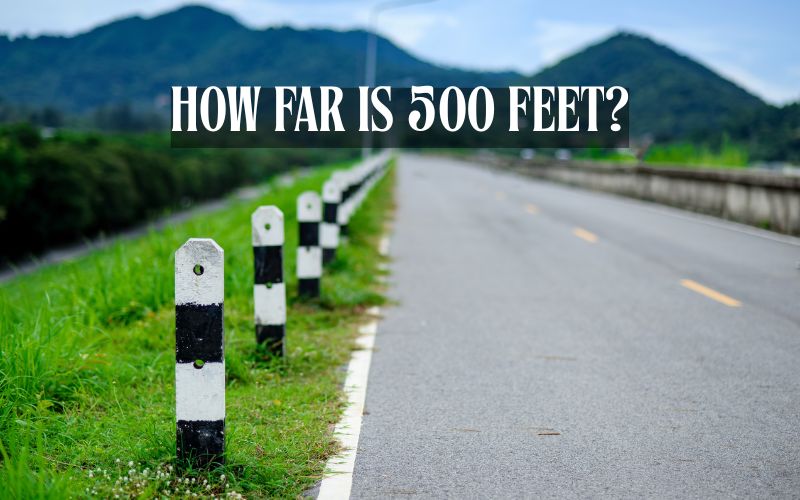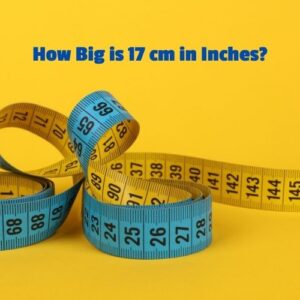Have you ever tried to imagine how far is 500 feet. It sounds like a big number, but it’s not always easy to picture. 500 feet is longer than a football field and much farther than most people think.
If you started walking, you’d need a little time to reach the end of 500 feet. It’s about the same as walking past a couple of city blocks or looking up at a tall building with 50 floors!
In this article, we’ll make it super easy to see how long 500 feet really is. We’ll talk about things you already know — like sports fields, streets, and buildings — so you can understand this distance without any measuring tools.
By the end of this article, you will have a solid understanding of 500 feet in real-world terms and how this measurement plays a significant role in everyday life.
What is a Foot? A Quick Overview
Before diving into 500 feet, it’s helpful to understand the foot and its role in both everyday measurements and various industries.
The foot (ft) is a unit of length in the imperial system, commonly used in countries like the United States, the United Kingdom, and other nations that still use the imperial system.
The foot is equal to 12 inches or 1/3 of a yard. The modern definition of the foot is based on the international yard, which is defined as exactly 0.9144 meters. Therefore, 1 foot is equal to 0.3048 meters.
The foot plays a significant role in defining small distances and is commonly used when measuring larger objects or distances in the U.S. Understanding 500 feet requires understanding how the foot fits into measurements.
How Far is 500 Feet? Visualizing the Distance
The key question here is: how far is 500 feet? To help you visualize 500 feet, we will compare this distance to several familiar objects, locations, and measurements in daily life. These real-world examples will allow you to see how 500 feet looks and feels across different contexts.

Visual Comparisons of 500 Feet
| Object/Location | Approximate Length | Comparison to 500 Feet |
|---|---|---|
| NFL Football Field (without end zones) | 360 feet | 500 feet is ~1.4 times longer |
| NFL Football Field (with end zones) | 400 feet | 500 feet is ~1.25 times longer |
| Average City Block | 200–300 feet | 500 feet is ~1.5–2.5 blocks |
| 50-Story Building Height | 500 feet | Equal to 500 feet |
The Length of a Football Field
One of the best ways to understand 500 feet is to compare it to the length of an American football field. An NFL football field measures 360 feet long (excluding the end zones). So, 500 feet would be almost 1.5 times the length of an entire football field. This gives you a tangible comparison because most people are familiar with football fields and can easily picture this length.
- End Zones: If we include the end zones, the total length of an American football field is about 360 feet + 20 feet (10 feet per end zone), making it a 400-foot field. Therefore, 500 feet would be slightly longer than a football field with end zones.
A Standard City Block
In many urban areas, the average length of a city block is between 200 and 300 feet. Therefore, 500 feet is roughly 1.5 to 2 city blocks long. This is a very helpful comparison when walking around a city or measuring distances in an urban environment.
For example, if you were walking down the street, 500 feet would likely take you about 2 to 3 minutes to walk, depending on your pace. It’s enough distance for a quick walk to a nearby store or cafe.
The Height of a 50-Story Building
To give you a sense of vertical space, imagine a 50-story building. A typical floor in a commercial building measures approximately 10 feet in height. Therefore, the height of a 50-story building would be around 500 feet. This comparison helps you visualize how tall 500 feet is when looking at large structures.
- Skyscrapers: In major cities like New York, Chicago, or San Francisco, skyscrapers typically range from 300 to over 1,000 feet in height. A 500-foot-tall building would be a moderately tall structure in a cityscape.
Walking Distance
If you are walking on foot, the average person walks at a speed of 3 to 4 miles per hour, or about 1,500 to 2,000 feet per minute. This means that 500 feet would take you about 15 to 20 seconds to walk at a moderate pace.
This comparison is especially useful when thinking about how far 500 feet is during your daily commute, errands, or other activities. For example, if you’re walking to a bus stop or the entrance of a large park, the distance could easily be around 500 feet.
The Length of a 5-Story Parking Garage
In many multi-story parking garages, a single floor or level of the garage typically measures around 100 feet long. So, 500 feet would be the approximate length of a 5-story parking garage, with each floor lined up end-to-end. This provides another practical comparison when visualizing 500 feet in the context of large parking facilities.
You May Also Need To Know: 15 Common Things That Are 100 Feet Long
Converting 500 Feet to Other Units
Understanding how 500 feet relates to other measurement systems is important for various fields. Here’s how 500 feet converts into other common units.

Conversions of 500 Feet to Other Units
| Unit | Conversion Formula | Result for 500 Feet |
|---|---|---|
| Yards | 500 ÷ 3 | 166.67 yards |
| Meters | 500 × 0.3048 | 152.4 meters |
| Miles | 500 ÷ 5280 | 0.0947 miles |
| Inches | 500 × 12 | 6,000 inches |
In Yards
Since 1 yard = 3 feet, converting 500 feet into yards is simple. You simply divide by 3:
500 feet÷3=166.67 yards500 \, \text{feet} \div 3 = 166.67 \, \text{yards}
So, 500 feet is equivalent to about 166.67 yards.
- Sports Fields: In sports like football and soccer, yards are commonly used, so this conversion is useful when discussing distances on the field.
In Meters
The metric system is used internationally, and the conversion from feet to meters is simple since 1 foot = 0.3048 meters. To convert 500 feet into meters:
500 feet×0.3048=152.4 meters500 \, \text{feet} \times 0.3048 = 152.4 \, \text{meters}
Therefore, 500 feet is equal to approximately 152.4 meters. This conversion is helpful for those using the metric system in countries such as Europe, Asia, and Australia.
In Miles
If you need to convert 500 feet into miles, you can use the conversion factor of 5280 feet = 1 mile:
500 feet÷5280=0.0947 miles500 \, \text{feet} \div 5280 = 0.0947 \, \text{miles}
Thus, 500 feet is about 0.095 miles or approximately 1/10th of a mile.
In Inches
To convert 500 feet into inches, multiply by 12 (since there are 12 inches in one foot):
500 feet×12=6,000 inches500 \, \text{feet} \times 12 = 6,000 \, \text{inches}
Therefore, 500 feet is equal to 6,000 inches. This conversion is particularly useful when working with more detailed or fine measurements, especially in fields such as engineering or craftsmanship. Also, you can check our free measurement tools.
Everyday Uses of 500 Feet
The 500-foot measurement is used in various aspects of life, whether you’re navigating urban spaces, working on home improvement projects, or dealing with landscape and engineering designs. Let’s look at a few of the most common everyday uses.

Practical Applications of 500 Feet
| Application | Context | Example Use of 500 Feet |
|---|---|---|
| Home Improvement | Fencing | Length of a fence line for a large yard |
| Landscaping | Garden Pathways | Total length of a pathway through a property |
| Sports | Baseball Field | Distance from home plate to outfield fence |
| Construction | Site Perimeter | Measuring a construction site’s boundary |
Home Improvement and DIY Projects
- Fence Heights: If you’re working on a fencing project, 500 feet can be the length of your fence line in a larger yard or property. Understanding this distance helps when purchasing materials like fencing posts, wire, or panels.
- Landscaping: For larger landscaping or gardening projects, 500 feet might represent the total length of the area you are planting trees, shrubs, or flowers. For instance, a 500-foot pathway in your garden could take you through a large property.
- Electrical Wiring: When laying down electrical wiring across a large area, such as a farm or industrial site, the 500-foot distance might be the span needed to connect buildings, power sources, or control systems.
Sports and Recreation
- Baseball Fields: In baseball, the outfield fence in some fields is 500 feet or more from home plate. This distance is used to measure how far the ball must travel for a home run.
- Running Tracks: The 400-meter running track at a high school or stadium has 4 corners, and 500 feet is roughly the length of half a lap on a standard track. 500 feet can be the distance that runners must go during certain training drills.
- Swimming Pools: Some competitive swimming pools can have lengths of 500 feet for extended laps or training sets, especially in large-scale competitions.
Airport Runways
When looking at airport runways, 500 feet is a critical safety distance. While a full runway typically measures much longer, 500 feet is sometimes used to measure safety margins and clear zones at the end of runways. For example, in smaller regional airports, 500 feet might be the width of the safety buffer area that allows planes to take off and land safely.
Construction Projects
In construction, 500 feet is used in surveying land, laying out buildings, or establishing property boundaries. 500 feet could represent a site perimeter, the length of a construction foundation, or even the distance between different parts of a site.
- Materials Handling: When handling large quantities of materials, such as cement, stone, or lumber, the 500-foot distance can be used to calculate the transportation needs and material distribution over a large construction area.
500 Feet in Engineering and Science
In fields like engineering, land surveying, and scientific research, precise measurements like 500 feet are used in planning, calculations, and experiments.
Geotechnical Engineering
In geotechnical engineering, 500 feet can represent a measurement of land, subsurface strata, or distance between structures for safety evaluations. 500 feet may be used in the analysis of seismic activity, soil testing, or structural integrity assessments.
Surveying and Mapping
When surveying land, 500 feet is often the reference point for boundary lines, distance calculations, or land area measurements. This measurement plays a crucial role in the design of infrastructure, such as roads, railways, or power lines.
Astronomical Measurements
In astronomy, 500 feet might be used as a baseline distance for measuring light telescopes, satellite dishes, or observatory domes on Earth. While astronomical units are often far larger than this distance, 500 feet serves as a modest reference point for equipment used in research.
You May Also Need to Know: How Long Is 10 Feet?
The Cultural and Historical Significance of 500 Feet
While 500 feet may seem like a common measurement today, it has also been significant in historical contexts. 500 feet has often been used to mark territorial boundaries or to set limits for various tasks or distances that needed to be measured.
Ancient Land Measurements
In many ancient cultures, the idea of measuring land and the distance between territories was a fundamental task. Ancient societies, including those in Rome and Greece, often relied on early forms of measurement to create borders or establish the boundaries of temples, farmlands, or even fortified cities.
- Roman Roads: Roman roads were constructed in straight lines across vast expanses of the empire, and measurements such as 500 feet helped the Romans map out distances between forts and military outposts.
The Influence of Ancient Measurements on Modern Society
Modern society still uses measurements like 500 feet in mapping, surveying, and land use planning. These practices have evolved significantly from their ancient uses, but the legacy of 500 feet remains embedded in the tools we use to define property boundaries, urban planning, and construction projects.
500 Feet in Technology and Innovation
With the rise of technology, 500 feet continues to have an important role in the design of products, systems, and devices.
Wireless Communications
In wireless communications, 500 feet can be the effective range for certain Wi-Fi signals or Bluetooth devices. Understanding this distance is important for network setup and the effective placement of routers or transmitters.
- Cellular Networks: The coverage radius of a typical cell tower can range from 500 feet to several miles, depending on terrain and network type. Knowing how 500 feet relates to signal propagation can help telecom engineers design efficient networks.
Manufacturing and Robotics
In robotics and automated systems, 500 feet is an important distance when calculating conveyor belt lengths, robotic arm movement, or transportation systems within large-scale factories.
- Automated Warehouses: In automated warehouses (like Amazon fulfillment centers), robots might travel 500 feet in search of items or to move goods. This movement can be tracked and optimized to increase the efficiency of warehouses.
Conclusion
Now you know how far 500 feet really is! It’s not just a number — it’s something you can see in your mind. It’s about as long as a football field and a bit more, or like walking past a few city blocks on a nice day.
You might not carry a ruler that long, but now you can easily guess this distance in real life. Whether you’re planning a small project, watching a game, or just curious, 500 feet won’t feel confusing anymore. You’ll be able to picture it clearly — every single time.
Convert Inches to Meters, cm, mm, and Feet
Converted Values:
Meters (m): 1.016
Centimeters (cm): 101.60
Millimeters (mm): 1016.00
Feet (ft): 3.33





